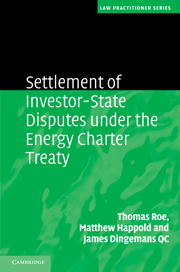Book contents
- Frontmatter
- Contents
- Foreword
- Preface
- Table of cases
- 1 Introduction
- 2 The applicable law
- 3 Availability of dispute settlement under Article 26
- 4 European Union law and the Energy Charter Treaty
- 5 Substantive law
- 6 Procedure
- 7 Contracting Parties' international responsibility for breaches of Part III of the ECT
- 8 Taxation
- Appendix A Selected provisions of the Energy Charter Treaty
- Appendix B Signatories to the Energy Charter Treaty
- Bibliography
- Index
5 - Substantive law
Published online by Cambridge University Press: 05 July 2011
- Frontmatter
- Contents
- Foreword
- Preface
- Table of cases
- 1 Introduction
- 2 The applicable law
- 3 Availability of dispute settlement under Article 26
- 4 European Union law and the Energy Charter Treaty
- 5 Substantive law
- 6 Procedure
- 7 Contracting Parties' international responsibility for breaches of Part III of the ECT
- 8 Taxation
- Appendix A Selected provisions of the Energy Charter Treaty
- Appendix B Signatories to the Energy Charter Treaty
- Bibliography
- Index
Summary
Introduction
The purposes of this Chapter are to identify the substantive obligations undertaken by parties to the Energy Charter Treaty concerning investments and to offer some suggested answers to particular questions of construction thrown up by their drafting. This Chapter does not, however, purport to offer an analysis of all aspects of the content of the obligations which it identifies. For the ECT, as with successive investment-protection treaties, incorporates standards of treatment whose general import, though not always whose precise meaning, is well understood from earlier treaties and from the practice of states and arbitral tribunals concerning them. The body of both arbitral case law and academic writing concerning these standards is vast and it is no part of this work's ambition to attempt either a comprehensive summary or a synthesis.
The scope of Part III of the ECT: investment promotion versus investment protection
The ECT's substantive provisions concerning investment are contained in Part III, entitled ‘Investment Promotion and Protection’. Investment promotion and investment protection are, of course, different things: the former is concerned with permitting, attracting and facilitating foreign investment; the latter, with the way in which an investment, once made, must be treated. As a matter of policy, the two are closely linked: the very purpose of undertaking, by treaty, to afford certain standards of treatment to foreign investments is to encourage the making of more such investments. As a matter of law, however, the ECT makes quite different provision as between promotion and protection.
- Type
- Chapter
- Information
- Publisher: Cambridge University PressPrint publication year: 2011



